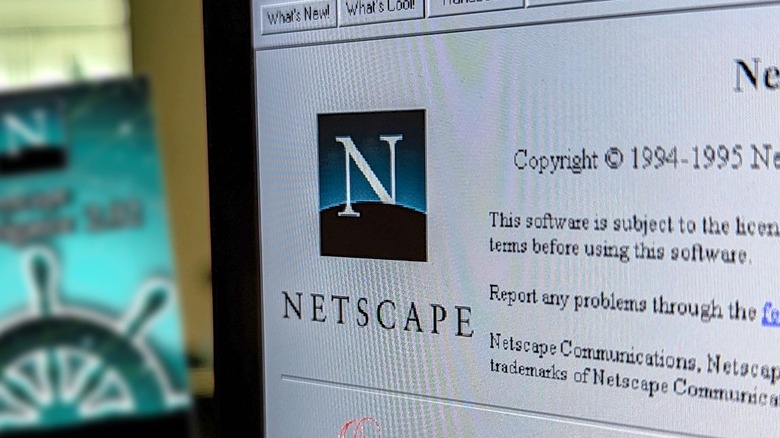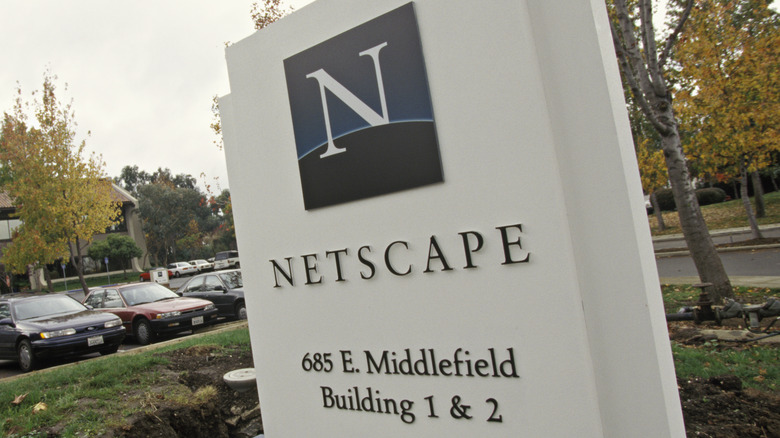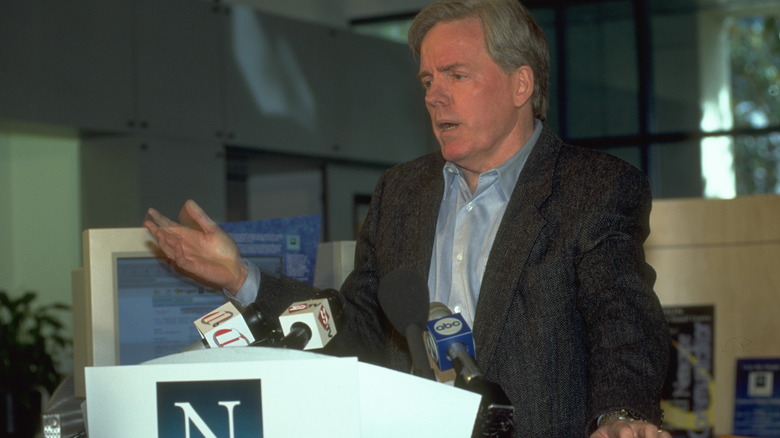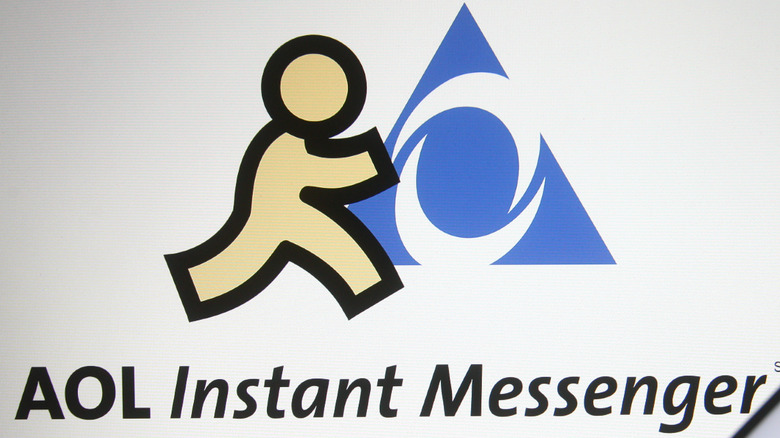The History Of Netscape Navigator: The Once Popular Web Browser Everyone Forgot About
The internet is full of the ghosts of old services that, while once triumphant beacons of the world wide web, have fallen into mere shells of their former selves or have simply died entirely. The examples are endless, from AOL Instant Messanger and MySpace to old filesharing services like Napster and Limewire.
One titan of the earlier days of the internet that is now mostly lost to the sands of time is Netscape Navigator. Netscape Navigator was an internet browser that was originally released in December 1994. At its height in 1996, the browser held over 75% of the market. For a browser of that level of popularity, it's surprising to think that it's virtually unheard of today. Even Internet Explorer is still remembered, albeit mostly for being unbearably slow in its twilight years.
Netscape Navigator's meteoric rise to prominence in the '90s is nearly dwarfed by its expeditious plummet to obscurity. The history behind the once titanic web browser had a simple beginning with a simple idea to rethink the way users access the internet.
The Early Internet Browsing Experience
To understand why Netscape Navigator took the world by storm, it's important to have a grasp on how unintuitive internet browsers were before Netscape Navigator hit the scene. In the earliest days of the world wide web, most browsers were nothing like what's seen on services like Google Chrome or Opera today. Most browsing was done in a completely text-based window, that featured no images and barely anything that could be clicked on.
Some of the innovations seen with the earliest browsers seem trivial today, but it's hard to deny that the step up to a graphical interface and searchable text with the Erwise browser wasn't a big deal at the time. In 1992, when Erwise was released, the future of the internet wasn't too far around the corner. Even at the time, it wasn't hard to see that the internet browsers of the day were beyond unusable to the average person. At the University of Illinois in 1993, an idea was in motion to dramatically change things.
Mosaic, The Netscape Precursor
Marc Andreessen studied at the University of Illinois where he earned a bachelor's degree in computer science. During his time in college, he interned twice for IBM. However, his most significant college achievement came in 1993 when Mosaic was released. Mosaic was a project led by Andreessen and his co-worker Eric Bina, and it was the internet browser that would eventually go on to become Netscape Navigator.
The idea for Mosaic came from Andreessen's experience with ViolaWWW, an early internet browser, and seeing an opportunity to make the whole thing more accessible. The center of Mosaic was a user-friendly design that came with features such as the use of photos, sounds, and hyperlinks. The basic ideas behind Mosaic are the foundations for the modern web browser. The browser's launch in 1993 saw it immediately shoot in popularity as one of the most-used browsers specifically because of its intuitive design. However, Mosaic was only the beginning of a long journey to market domination.
Enter Netscape
After graduating college Andreessen met Jim Clark, the founder of Silicon Graphics, or SGI as it was later known. Silicon Graphics did work on creating high-performance computers that were used for various rigorous needs, such as VFX rendering for movies like Jurassic Park. Andreessen and Clark partnered up and, after initially setting out to do some work related to video games, ended up hiring the Mosaic team.
In April of 1994, Andreessen and Clark formed Mosaic Communications Corporation. However, before an actual product could be released, one significant and recurring issue presented itself to the Mosaic team: the ownership of Mosaic. The University of Illinois held intellectual property rights to the browser Andreessen and Bina had created. Without many other options, the team set out to rebuild from scratch.
However, the complete rebuild didn't hold off the University of Illinois, who still sued Mosaic Communications for infringing their intellectual property. In early December of 1994, a settlement was reached that saw the University of Illinois receive a multi-million dollar payout and forced Andreessen and Clark to rename the company "Netscape." While things might have looked very grim, a dramatic upturn was just around the corner.
The Success of Netscape Navigator
Although the company had released iterations of their Mosaic and Mosaic Netscape browsers, in the midst of December 1994 the company had their 1.0 release which saw their browser's name definitively change to Netscape Navigator. The browser was an instant success. The same design principles that made Mosaic such a step up in the first place were still present, but so much more had been added by the skilled Netscape team. The biggest new innovation came with the creation and implementation of the SSL protocol.
SSL is an acronym standing for Secure Sockets Layer. The SSL Protocol is used to keep data transfers between clients and servers secure and private. The protocol begins with a handshake, where the client and the server agree on encryption algorithms and exchange digital certificates. The client generates a session key, shared with the server for data encryption. Once established, data is securely transmitted using symmetric encryption. SSL ensured privacy, data integrity, and server authentication, safeguarding sensitive information during transmission. SSL, while not the standard of today, provided the groundwork for TLS (Transport Layer Security) protocol.
After launching Netscape Navigator, the company saw steady growth upwards. The instant success of the browser saw rapid growth for the company all throughout 1995. Netscape went public in August of that year, in a frenzied Wall Street debut that saw the company nearly immediately being worth billions of dollars. At this monumental height, Netscape held a commanding 80 percent of the market. However, around that time a new competitor was stirring to shake up the browser market.
The Microsoft in the Room
Although Netscape held dominion over the world of internet browsing in 1995, the realm of operating systems was firmly held down by Microsoft. The same month that Netscape went public, Microsoft would release Windows 95. While Windows 95 could look "dull" and "ancient" to modern eyes, at its release it was revolutionary. In the same way Mosaic, and later Netscape Navigator, had been built on user-friendliness and accessibility to the average person, Windows 95 had been built around much the same principle. The OS was popular enough to still hold an over 50 percent market share seven years after its release.
A few months before the launch of Windows 95, Microsoft allegedly approached Netscape to propose a deal. Though Microsoft disputes how these events went in exact detail, the much larger tech company had supposedly wanted to split up the market for browsing between themselves and Netscape. The deal was refused, but ultimately, Microsoft had an ace up its sleeve. On the same day Windows 95 was released, the Microsoft Plus! expansion was released alongside it. Included in this expansion was the first release of Internet Explorer.
Ironically, Internet Explorer was built using code from Spyglass, Inc.'s Mosaic, which in turn came from ties the company had to the National Center for Supercomputing Applications at the University of Illinois. Spyglass had sold the Mosaic browsing technology to 120 companies, but Microsoft's Internet Explorer had one distinct advantage head-and-shoulders above all others, including Netscape. That advantage was the ability to bundle their browser within Windows.
Antitrust Wrist Slap
The earliest versions of Internet Explorer were not nearly as feature-rich as their Netscape contemporaries, but the convenience afforded by having it bundled in with Windows in addition to the cost saved was a huge blow to Netscape. Netscape Navigator held dominant through all of 1996 and 1997, but they were losing ground to Microsoft's Internet Explorer.
The momentum of Internet Explorer was impeded at multiple points, including lawsuits from both Spyglass and SyNet Inc, both of which ended with Microsoft paying out multi-million dollar settlements. In 1998 the biggest challenge possible presented itself to Microsoft when the Attorney General's office began pursuing an antitrust case. However, by the time this happened, Microsoft was already neck-and-neck with Netscape. By the year's end, Internet Explorer was the dominant browser and Netscape Navigator would never recover its spot on top. Internet Explorer maintained its sport as the top browser until it was unseated by Google Chrome nearly 15 years later.
As for the results of the Antitrust case against Microsoft, it was ultimately determined that Microsoft had engaged in predatory behavior towards Netscape. Courts had originally ordered that Microsoft be broken up, but the D.C. Circuit Court of Appeals later rejected that remedy and it was later settled that Microsoft would make it easier for competitors to get their software on Windows. By the time this was all decided in the early 2000s, it was far too late for Netscape Navigator.
AOL and Decline
Throughout the "browser wars" with Microsoft, Netscape did significantly improve during the rise of Internet Explorer. In September 1995, the 2.0 version of Netscape Navigator was released. The primitive Internet Explorer that had come out publicly the previous month wasn't anywhere near Netscape's improved browser. While Internet Explorer was playing catch-up with features of Netscape Navigator's 1994 release, Netscape had incorporated features such as Java applets, FTP uploading, and plug-ins. Perhaps most notably, Netscape Navigator 2 was the first browser to support animated GIFs.
However, the innovation on Netscape's end was no match for the powerhouse that was and still is Microsoft. As Microsoft continued to improve Internet Explorer, it soon caught up to Netscape Navigator. The further things went, the better Internet Explorer got until it was finally just as good, if not better in some areas, than Netscape Navigator. The improved Internet Explorer combined with the convenience of already being loaded onto Windows made the tides change quickly in Microsoft's favor.
In the late months of 1998, AOL announced that it was purchasing Netscape and the deal later closed in 1999. The deal was valued at $10 billion. By the end of 2003, AOL had disbanded Netscape. Iterations of the Netscape browser were continually released by AOL, although they were developed by AOL staff rather than the Netscape team. The Netscape Navigator name returned for one last release in October 2007. Netscape Navigator 9 was the final version of the browser, and it only held 0.6% of the market for browsers upon release. Support for the browser was officially discontinued in 2008.
The Netscape Legacy
Although Netscape Navigator is gone and for the most part forgotten, its legacy is still felt all throughout the modern web browsing experience. First and foremost, Mozilla Firefox is often considered a spiritual successor or descendant of Netscape Navigator. Early in 1998, Netscape released most of its code base. What came from the newly open-source Netscape code base was Mozilla. The name had come from Netscape's code name for Navigator as well as their mascot, with the word itself being a portmanteau of Mosaic and Godzilla. The mascot itself was a green and purple lizard.
In 2003 when AOL disbanded Netscape, the Mozilla Foundation was founded on the same exact day. The initial Mozilla Browser was a part of the Mozilla software suite, however, some engineers within Mozilla saw the suite as growing bloated. To combat this, they created a standalone Mozilla browser that would eventually become Firefox. The browser was originally called Phoenix, as it was supposed to have "risen from the ashes" of Netscape Navigator.
Besides the direct line of succession with Firefox, Netscape Navigator's influence is seen everywhere. The original line of thought behind the browser, to make things more user-friendly and accessible, still underlines most progression within browsers today. The innovations made by Netscape can still be seen as foundations of the internet as we know it today, be it secure browsing or watching GIFs. The history of Netscape Navigator is one of both frenetic rise and catastrophic fall, but its history is also a look back at the building blocks on which all modern web browsers stand.








